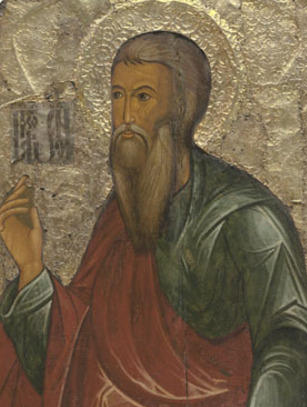
Seth, in the Abrahamic religions, was the third son of Adam and Eve. According to the Hebrew Bible, he had two brothers: Cain and Abel. According to Genesis 4:25, Seth was born after Abel's murder by Cain, and Eve believed that God had appointed him as a replacement for Abel.

Cain is a biblical figure in the Book of Genesis within Abrahamic religions. He is the elder brother of Abel, and the firstborn son of Adam and Eve, the first couple within the Bible. He was a farmer who gave an offering of his crops to God. However, God was not pleased and favored Abel's offering over Cain's. Out of jealousy, Cain killed his brother, for which he was punished by God with the curse and mark of Cain. He had several children, starting with Enoch and including Lamech.

The wives aboard Noah's Ark were part of the family that survived the Deluge in the biblical Genesis flood narrative from the Bible. These wives are the wife of Noah, and the wives of each of his three sons. Although the Bible only notes the existence of these women, there are extra-biblical mentions regarding them and their names.

Enos or Enosh is a figure in the Book of Genesis in the Hebrew Bible. He is described as the first son of Seth who figures in the Generations of Adam, and is also referred to within the genealogies of 1 Chronicles.
In Mandaeism, Ptahil also known as Ptahil-Uthra, is the Fourth Life, the third of three emanations from the First Life, Hayyi Rabbi, after Yushamin and Abatur. Ptahil-Uthra alone does not constitute the demiurge but only fills that role since he is viewed as the creator of the material world in the Ginza Rabba, often holding an inherently malicious character.
An uthra or ʿutra is a "divine messenger of the light" in Mandaeism. Charles G. Häberl and James F. McGrath translate it as "excellency". Jorunn Jacobsen Buckley defines them as "Lightworld beings, called 'utras ." Aldihisi (2008) compares them to the yazata of Zoroastrianism. According to E. S. Drower, "an 'uthra is an ethereal being, a spirit of light and Life."
The Right Ginza is one of the two parts of the Ginza Rabba, the longest and the most important holy scripture of Mandaeism. The other part of the Ginza Rabba is the Left Ginza.
In Mandaeism, Yushamin and also known as the 'Second Life', is the primal uthra and a subservient emanation who was created by the Mandaean God 'The Great Life', hence beginning the creation of the material world. Yushamin is the father of Abatur. Jorunn J. Buckley identifies Yushamin as "both a Lightworld utra beyond reproach and the prototype of a priest who has made mistakes in ritual."
In Mandaeism, Manda d-Hayyi or Manda ḏ-Hiia is an uthra sent by the Great Life as a messenger to John the Baptist. Manda d-Hayyi is considered to be the most important uthra, since he is the one bringing manda to Earth (Tibil).
In Mandaeism, Hayyi Rabbi, 'The Great Living God', is the supreme God from which all things emanate.
In Mandaeism, Hibil or Hibil Ziwa is an uthra from the World of Light. Hibil is considered to be the Mandaean equivalent of Abel.
In Mandaeism, Shitil is an uthra from the World of Light. Shitil is considered to be the Mandaean equivalent of Seth.
In Mandaeism, Qin is the mother of Ruha and Zahreil, and grandmother of Ur in the World of Darkness or underworld. In Mandaean texts, she is frequently mentioned as the "queen of darkness." One of her epithets is Sumqaq, which also refers to a well of polluted water in the World of Darkness. Her husband is the demon Anathan.
In Mandaeism, Adathan and Yadathan are a pair of uthras who stand at the Gate of Life in the World of Light, praising and worshipping Hayyi Rabbi. In the Ginza Rabba and Qulasta, they are always mentioned together. Book 14 of the Right Ginza mentions Adathan and Yadathan as the guardians of the "first river".
In Mandaeism, Shilmai or Shalmai (Šalmai) is an uthra who serves as one of the two guardian spirits of Piriawis, the heavenly yardna (river) in the World of Light. In the Ginza Rabba and Qulasta, he is usually mentioned together with Nidbai.
In Mandaean cosmology, the Sea of Suf is a primordial sea in the World of Darkness. It is analogous to Tehom in the Book of Genesis. It is a great sea that the soul has to pass in the first steps of ascending, and is also considered to be the limit of worldly desire.
In Mandaeism, Yawar Ziwa is an uthra from the World of Light. He is the personification of light.
The Mandaic word mana (ࡌࡀࡍࡀ) is a term that is roughly equivalent to the philosophical concept of nous. It has been variously translated as "mind", "soul", "treasure", "Garment", "Intellect", "Intelligence", "Heart", "Spirit", "Being"; or alternatively as "nous", "consciousness", or "vessel".
In Mandaeism, Anathan or Anatan is a demon in the World of Darkness or underworld. He is the husband of Qin, a demoness who is the mother of Ruha and Zahreil. Hibil Ziwa encounters Anathan during his descent to the World of Darkness in Chapter 1 of Book 5 in the Right Ginza. In the aforementioned chapter, Anathan is described as "the warrior of darkness" and also as a "warlike giant." Together with Qin, the couple is described as the "giants of darkness".
In Mandaeism, Anush or Anush Uthra is an uthra from the World of Light. Anush is considered to be the Mandaean equivalent of Enos.









